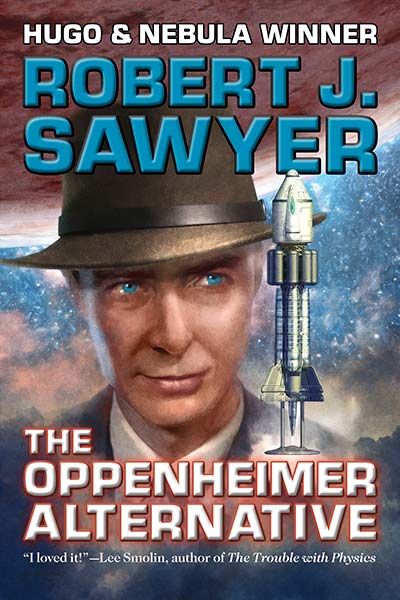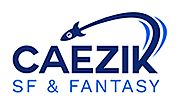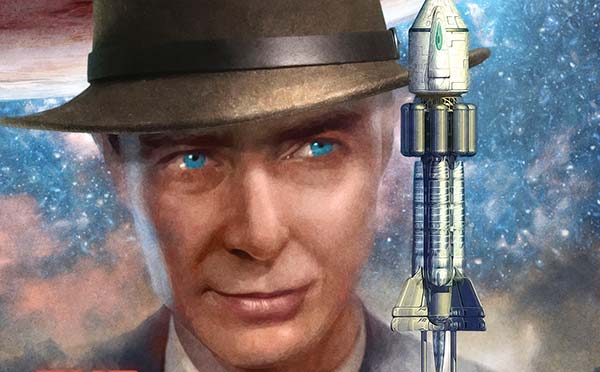Eye on the Indies:
A Look at Indie Authors and Their Publishers
By Lanie Tankard, Indie Book Review Editor
The Oppenheimer Alternative by Robert J. Sawyer (Rockville, Maryland: CAEZIK SF & Fantasy, an imprint of Arc Manor LLC, June 2, 2020; 374 pages; $16.99; trade paper ISBN 978-1-64710-013-1). Published in Canada by Red Deer Press in Markham, Ontario, May 15, 2020. Ebook published directly by the author.
“Despite all disclaimers, it is only when science asks why, instead of simply describing how, that it becomes more than technology. When it asks why, it discovers Relativity. When it only shows how, it invents the atom bomb, and then puts its hands over its eyes and says, My God what have I done?”
—Ursula K. Le Guin, “The Stalin in the Soul”
(in The Language of the Night: Essays on Fantasy and Science Fiction, Susan Wood, ed., 1979, p. 219. Also in The Future Now: Saving Tomorrow, Robert Hoskins, ed., 1977)

Seventy-five years ago this month, a fiery mushroom cloud rose forty thousand feet over the desert near Alamogordo, New Mexico. The world’s first atomic bomb, developed under the secret Manhattan Project, detonated on July 16, 1945, during the Trinity Test—launching the Atomic Age.
The “father of the atomic bomb” was theoretical physicist J. Robert Oppenheimer, who garnered that unofficial title because he was scientific director at the Manhattan Project’s Los Alamos site. Just nine years later, however, during the McCarthy Era, “Oppie” would have his security clearance revoked by the Atomic Energy Commission in covert hearings.
Numerous words have been written about these events: Biographies, histories, poetry, plays, memoirs, essays, lectures, and novels—in addition to images created in comics, photos, films, documentaries, and television shows. Now Canadian author Robert J. Sawyer has added a science fiction twist to the mix, blending fact and imagination in his new book The Oppenheimer Alternative. It’s an original approach and a fascinating read.
Sawyer sticks to the historical record while fleshing out his dramatis personae—high-level scientists in the Manhattan Project. By now, many are well-recognized names: Albert Einstein, Edward Teller, Wernher von Braun, Enrico Fermi, Niels Bohr, Freeman Dyson, Richard Feynman, Leo Szilard, and John von Neumann—to list but a few. Sawyer establishes their relationships, to one another and to their families. He probes this intricate network, focusing on Oppenheimer. He also highlights the roles played by two women in Oppie’s life: Kitty (his wife) and Jean Tatlock (his love). Sawyer sets scenes with vivid details likely observed in photographs, and he conjectures various conversations.
One nonscientist is a prominent character in the book: General Leslie R. Groves, head of the entire Manhattan Project. The interactions between Groves and Oppenheimer form the critical mass (k = 1) that generates fission and creates a bomb: Oppie knows just which scientists to recruit and Groves knows just how to fund it—as long as the government’s rules are followed and they get to smash not one, but two cities in Japan to bits.
And so they do: First Hiroshima on August 6 with a uranium-235 bomb called “Little Boy” and then Nagasaki on August 9 with a plutonium bomb called “Fat Man.” After witnessing the devastation they had wrought, Oppie and the other architects of destruction balk at future endeavors.
Ah, but there’s always that “Dr. Strangelove” kid who just can’t stop playing with matches. Edward Teller wants to push ahead to nuclear fusion, creating an even bigger boom by yoking the power of the sun. Dreaming of glory as “the father of the hydrogen bomb,” he has trouble harnessing his jealousy while waiting to nudge “the father of the atomic bomb” out of the way. And in a symbolic way, Teller does end up destroying Oppenheimer in his testimony before the Atomic Energy Commission. But then, well, Teller’s peers shun him for it.
It’s Oppie though who takes center stage in Sawyer’s book, with his perpetual porkpie hat and pipe (or omnipresent nervous cigarette). When Sawyer starts subtly twisting reality, it’s hard to tell when the time warp actually begins. As the book springboards from fission to fusion, Sawyer’s already established the personalities and motivations of each actor so well that the storyline’s quest feels eminently plausible: Can this A-team of geniuses save future humanity in an alternate history?
For in Sawyer’s sci-fi imagination, Teller’s fusion research has unearthed a disturbing detail—in less than a hundred years, the sun will expel its outer layer. The team of physicists quickly realizes what that means: All the planets comprising the inner solar system, which of course includes Earth, will be extinguished. Can they move Homo sapiens off the globe to another habitat in time? Where? How? And which ones?
What Sawyer pens is a Greek tragedy of sorts, a Shakespearean drama with dueling senses of self-worth. He has a field day inserting literary Easter eggs (hidden references or “winks”). On his website, he includes an entire section explaining just where he deviated from recorded history to create the fiction—with a wise caveat to avoid looking at it until you finish reading the book.
Stephen King believably combined time travel with an attempt to change the past in his novel 11/22/63. Sawyer imagines an alternate history that can change the future, theorizing here to predict that which has not actually been observed—just like quarks. His take on the progression of science and its real-world applications is quirky, but it’s conceivable.

Author photo by Bernard Clark
The Manhattan Project was a momentous undertaking. Sawyer’s approach here is also extensive. He heightens the large elements in these characters’ temperaments and then watches them collide as if he were using a particle accelerator at CERN or SLAC.
British author Michael Frayn combined several of these larger-than-life personalities in his brilliant play Copenhagen. In Frayn’s stage setting, Danish physicist Niels Bohr and his wife Margrethe have a visit from German physicist Werner Heisenberg, who had worked with Bohr trying to split the atom before World War II. It’s Margrethe, the character Frayn uses to represent all the nonscientists on Earth, who poses a question to the two men at play’s end:
“And when all our eyes are closed, when even our ghosts are gone, what will be left of our beloved world? Our ruined and dishonoured and beloved world?”
Robert J. Sawyer seems to have wondered, too. He conjured up an answer through science fiction. The Oppenheimer Alternative is astutely timed for the seventy-fifth anniversary of the A-bomb. The book is not only educational and well written, it’s also a fun read. It takes the atomic genre through a portal “to infinity and beyond.”
Canadian science fiction writer Robert J. Sawyer is the author of twenty-four novels (nine of which are trilogies) and two short-story collections. His numerous prizes include the 1995 Nebula Award for Best Novel for The Terminal Experiment, the 2003 Hugo Award for Best Novel for Hominids, the 2006 John W. Campbell Memorial Award for Mindscan, and the 2017 Robert A. Heinlein Award for hard science fiction inspiring space exploration.
Sixteen of his books garnered Aurora Awards from the Canadian Science Fiction and Fantasy Association, and he was inducted into the CSFFA Hall of Fame for lifetime achievement in 2013. His book FlashForward, which also won the Aurora, was the basis for an ABC television show. Sawyer won the 2014 Skylark Award from the New England Science Fiction Association.
Sawyer is a past president of the Science Fiction and Fantasy Writers of America (1998–1999) and a member of the Order of Canada. He graduated from the Radio and Television Arts Program at Ryerson University in Toronto, where he has been an instructor. Sawyer also taught creative writing at the University of Toronto, Humber College, and the Banff Centre. He has been writer-in-residence at the Toronto, Richmond Hill, and Kitchener Public Libraries, as well as the Canadian Light Source (Canada’s national synchrotron in Saskatoon).
Publisher: CAEZIK SF & Fantasy
 CAEZIK SF & Fantasy is an imprint of Arc Manor Publishers in Rockville, Maryland. Publisher Shahid Mahmud started Arc Manor, a member of the Independent Booksellers Association, in 2006 and created Phoenix Pick as an SF/Fantasy imprint. In 2013, he began Galaxy’s Edge magazine. Mahmud was a San Diego bond portfolio manager before he went into publishing.
CAEZIK SF & Fantasy is an imprint of Arc Manor Publishers in Rockville, Maryland. Publisher Shahid Mahmud started Arc Manor, a member of the Independent Booksellers Association, in 2006 and created Phoenix Pick as an SF/Fantasy imprint. In 2013, he began Galaxy’s Edge magazine. Mahmud was a San Diego bond portfolio manager before he went into publishing.
Copyright 2020 Woven Tale Press LLC. All Rights Reserved

